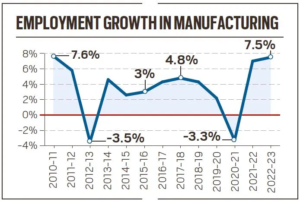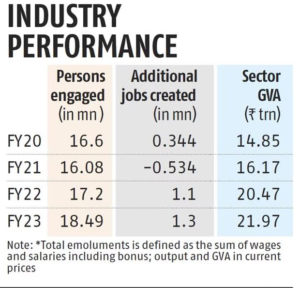GS Paper 3: Indian Economy, Infrastructure, Growth & Development For Prelims: Annual Survey of Industries ASI, Gross Value Added GVA, Gross Domestic Product (GDP), Net Value Added, National Statistical Office (NSO) |
Why is this in the news?
The Ministry of Statistics and Programme Implementation (MoSPI) has recently published the Annual Survey of Industries (ASI) for the year 2022-23, offering important insights into the revival and expansion of India’s manufacturing sector.
- The fieldwork for the survey took place between November 2023 and June 2024 for the ASI 2022-23.
Key Highlights of the ASI Report 2022-23:
- Growth in Manufacturing Employment:
The ASI report reveals that employment in manufacturing rose by 7.5%, from 1.72 crore in 2021-22 to 1.84 crore in 2022-23. This marks the highest growth rate in the past 12 years. - The sector added 13 lakh new jobs in 2022-23, up from 11 lakh in the previous fiscal year.
- Growth in Gross Value Added (GVA) and Outcome:
The manufacturing sector’s GVA grew by 7.3%, reaching Rs 21.97 lakh crore in 2022-23, compared to Rs 20.47 lakh crore in 2021-22.
- Industrial input rose by 24.4%, while output grew by 21.5% in 2022-23, indicating a significant recovery in the manufacturing sector.
Key Drivers of Manufacturing Growth:
The primary contributors to manufacturing growth in 2022-23 were basic metals, coke and refined petroleum products, food products, chemicals, and motor vehicles.
- Together, these industries contributed around 58% of the total output.
Regional Performance:
The top five states in terms of employment were Tamil Nadu, Maharashtra, Gujarat, Uttar Pradesh, and Karnataka.
Increase in the Number of Factories:
The number of factories rose from 2.49 lakh in 2021-22 to 2.53 lakh in 2022-23, indicating the first full recovery phase post-Covid-19 disruptions.
Decline in the Informal Sector:
Employment in the informal sector dropped by 1.5%, with 16.45 lakh fewer workers, reaching 10.96 crore in 2022-23. This suggests a shift toward formal employment in manufacturing, as per the Annual Survey of Unincorporated Enterprises (ASUSE) 2022-23 released in July 2024.
Average Salaries:
The average earnings per person increased by 6.3%, reaching Rs 3.46 lakh in 2022-23 compared to the previous year.
Surge in Capital Investment:
Gross fixed capital formation (GFCF) saw a rise of over 77%, reaching Rs 5.85 lakh crore in 2022-23, while net fixed capital formation increased by 781.6% to Rs 2.68 lakh crore, supporting sustained growth in manufacturing.
- GFCF, also known as “investment,” refers to the acquisition of produced assets, including second-hand purchases and the production of assets for self-use, minus disposals.
- Net fixed capital formation refers to GFCF minus the consumption of fixed capital.
- Profits in the manufacturing sector also grew by 2.7%, reaching Rs 9.76 lakh crore.
Note:
- Workers include all those directly or indirectly employed, including unpaid workers and those engaged in activities such as cleaning machinery.
- Employees encompass all paid workers, including those in supervisory or managerial roles, and those handling purchasing and security duties.
Gross Value Added (GVA):
- GVA represents the value that producers add to goods and services during the production process.
- It is calculated by subtracting input costs (intermediate consumption) from the total output.
As a key component of GDP, GVA growth offers insights into economic performance and helps in formulating economic policies.
- Net Value Added (NVA) is calculated by deducting depreciation from GVA, representing the value after subtracting both intermediate consumption and fixed capital depreciation.
What is the Annual Survey of Industries (ASI)?
- Overview:
The ASI is the primary source of industrial data and statistics in India.- It began in 1960, using 1959 as its base year, and has been conducted annually since then, except for 1972, under the Collection of Statistics Act of 1953.
- Since 2010-11, the survey has been carried out under the Collection of Statistics Act, 2008, which was amended in 2017 to cover the entire country.
- Implementing Agency:
The National Statistical Office (NSO), under the MoSPI, conducts the ASI and ensures the accuracy of the data. - Scope and Coverage:
ASI covers the entire country and includes all factories registered under the Factories Act, 1948, and bidi and cigar manufacturing establishments.- Electricity companies involved in generation, transmission, and distribution that are not registered with the Central Electricity Authority (CEA) are also included.
- Units with 100 or more employees listed in the Business Register of Establishments maintained by state governments are part of the survey.
- Data Collection Mechanism:
Data is collected from selected factories following the Collection of Statistics Act, 2008, and the rules laid down in 2011.
Opportunities and Challenges for India’s Manufacturing Sector:
- Opportunities:
- Large Domestic Market and Demand: The Indian manufacturing sector has experienced strong demand from both domestic and global clients.
- The Purchasing Managers’ Index (PMI) stood at 58.8 in May 2024, reflecting expansion in manufacturing.
- Sectoral Growth: Key sectors like chemicals, pharmaceuticals, automotive, electronics, industrial machinery, and textiles have shown remarkable growth.
- Manufacturing costs for pharmaceuticals in India are 30%-35% lower than in the US and Europe.
- Global Market Access: Indian manufacturing has shifted from European to Asian Global Value Chains (GVCs), with foreign value-added from the Global South increasing significantly.
- This presents Indian firms with the chance to establish their own GVCs and position India as a growth hub.
- Growth of MSMEs: Micro, Small, and Medium Enterprises (MSMEs) contribute around 30% to India’s GDP and play a crucial role in driving economic growth, accounting for nearly 45% of exports.
- As of March 2024, more than 4 crore MSMEs were registered on the Udyam portal, with 67% being manufacturing MSMEs.
- Growth Potential: The Indian manufacturing sector has the potential to reach USD 1 trillion by 2025, underlining its critical role in the economy.
- Large Domestic Market and Demand: The Indian manufacturing sector has experienced strong demand from both domestic and global clients.
Challenges:
Outdated Technology and Infrastructure: Reliance on outdated technology and weak infrastructure hampers India’s ability to compete globally and meet quality standards.
Lack of Skilled Workforce: The World Bank reports that only 24% of India’s workforce has the skills required for complex manufacturing, compared to 52% in the US and 96% in South Korea.
High Input Costs: India’s logistics costs are 14% higher than the global average, according to the Reserve Bank of India (2022), which affects the competitiveness of the manufacturing sector.
- Additionally, the land acquisition process in India is complex.
Competition from China and Import Dependence: In 2023-24, China accounted for nearly 42% of India’s textiles and clothing imports, 40% of machinery imports, and 38.4% of electronics imports.
Government Initiatives to Boost Manufacturing in India:
- Production-Linked Incentive (PLI)
- PM Gati Shakti – National Master Plan
- Bharatmala and Sagarmala Projects
- Start-up India
- Make in India 2.0
- Atmanirbhar Bharat Campaign
- Special Economic Zones (SEZs)
- Liberalized Foreign Direct Investment (FDI)
- MSME Innovative Scheme
- Ease of Doing Business
- GST and Corporate Tax Reduction
Way Forward:
- Infrastructure Investment: Improving infrastructure and reducing logistics costs can attract more investment in manufacturing.
- Industry 4.0 Adoption: Promoting Industry 4.0 could help manufacturing contribute 25% of GDP by FY26. Increased investment in digital transformation is essential.
- Promoting Export-Oriented Manufacturing: Supporting export-oriented manufacturing can help Indian firms expand into new markets and enhance competitiveness.
- Financial Support: Many MSMEs struggle to secure export credit, so increased financial support for these businesses is essential.
- Streamlining Regulations: Simplifying regulations can encourage investment and reduce the burden on businesses.
- Skill Development: Expanding training programs can help address the shortage of skilled labour and increase the sector’s global competitiveness, as demonstrated by Vietnam.
Explore our Books: https://apnipathshala.com/product-category/books/
Explore Our test Series: https://tests.apnipathshala.com/











